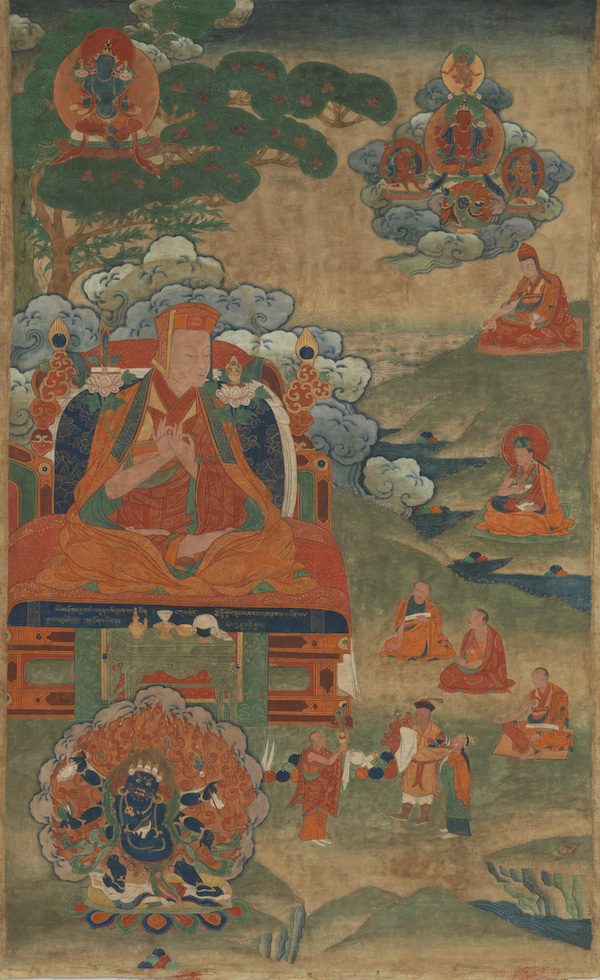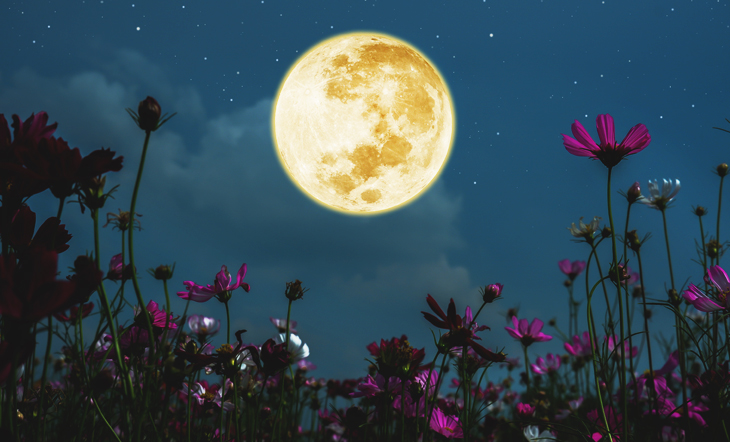Sex and Gender Fluidity in Tibetan Buddhism
A Tibetan scholars’s dream uniquely presents sex changes without judgement—neither as as biological fact nor pedagogical tool, but as an expression of intimacy with another person. The post Sex and Gender Fluidity in Tibetan Buddhism appeared first on Tricycle:...

 Jamgon Kongtrul Lodro Thayl (1813-1899)Tibet late 19th century | Pigments on cloth |
Rubin Museum of Art
C2003.25.2 (HAR 65265)
Jamgon Kongtrul Lodro Thayl (1813-1899)Tibet late 19th century | Pigments on cloth |
Rubin Museum of Art
C2003.25.2 (HAR 65265)The Sources of Buddhist Traditions is a monthly column from three of the major digital resources for Buddhist research, texts, and translation: Buddhist Digital Resource Center, The Treasury of Lives, and 84000: Translating the Words of the Buddha. Focusing on stories, texts, translation, and teachers, the series will illuminate aspects of Buddhist practice, thought, and tradition.
Buddhists have been switching genders for hundreds of years, either temporarily, permanently, or in dreams and visions. They do it for many reasons—to teach wisdom, or ethics, or just to provide a means for comforting a friend.
Stories of fluid sexual identities abound in Buddhist literature. In medical treatises, scripture, and biographies, one can read detailed descriptions of individuals who have transitioned from one sex to another and a wide range of theories as to why and how this happens. Stories that depict the fluidity of sex (physical characteristics), gender (how one presents), and sexuality (the object of desire relative to the sex of the individual) generally tend toward the fantastical, using supernatural events to teach nonduality, as in the Vimalakirti Sutra, or toward the didactic, in which the transformations are punishment for sin or rewards for meritorious deeds.
In Tibetan biographical literature, one occasionally comes across individuals who changed from male to female or from female to male, usually without much explanation. For example, Rasey Konchok Gyatso’s recent survey of historical Tibetan women includes a fifteenth-century woman named Jetsun Khacho Wangmo, a disciple of Tsongkhapa Lobzang Drakpa, who was born a boy but became a girl, after which she entered a nunnery and became an influential teacher. There’s a Bon master named Lishu Takring who was born a girl and intentionally transformed herself into a man through rituals she herself developed, going on to become a Dzogchen master. And some recent masters such as Adzom Drukpa (1842–1924) were also said to have worn clothing customarily gendered as female in order to accord with a prophecy.
There are also the stories in the biographies of individuals for whom, at least in their dreams, sex and gender fluidity is presented neither as as biological fact nor pedagogical tool, but rather as an expression of intimacy with another person. The autobiography of Tibetan master Jamgon Kongtrul (1813-1899) provides a moving example of this, in a passage following the death of his mother.
***
Jamgon Kongtrul is well known for his great compendiums such as the Treasury of Revelation and the Treasury of Knowledge, as well as rimé, his nonsectarian approach to the teachings of the Buddha His collaborations with teacher and scholar Jamyang Khyentse Wangpo (1829-1892) and with the treasure revealer Chokgyur Lingpa (1892-1870) are also famous, largely due to the astonishing amount of textual resources the three produced together. Yet those relationships extended beyond the professional—Kongtrul and Khyentse, in particular, were dear friends who met on a personal, emotional level, albeit in a friendship that was entirely conducted in religious contexts.
For example, in 1848, when Khyentse was broken-hearted over the death of his elder brother, and Kongtrul was newly returned from a two-year trip to the Gyarong region, Khyentse wrote to Kongtrul:
Now that you have come back, I am glad almost to the point of forgetting my grief. I need to come now and receive the complete empowerments for the tantras of the Jonang tradition.
For two lamas whose sole language for arranging visits—and expressing affection—was religious, Khyentse’s request for an empowerment was his way of asking to spend quality time with a dear friend in a moment of grief. If they had both been professional soccer players, Khyentse would have likely proposed a scrimmage. Had they been musicians, they would have gotten together to jam. As religious masters, being together meant doing religion.
Twenty years later, religious imagery would be the framework of a dream in which Khyentse consoled Kongtrul in his grief. After Kongtrul’s beloved mother died in the spring of 1867, he turned to Khyentse in his grief. That summer, Khyentse responded to that loss by relating to Kongtrul an extensive dream.
The dream began with Khyentse in the form of a woman named Dorje Tso, the wife of an unnamed householder in Lhodrak, in central Tibet. One evening Dorje Tso’s husband announced that a lama would be coming for a visit, and that she should prepare the house, which she did, cleaning and arranging a place for the lama to sit and sleep. A short, corpulent lama soon arrived; he was Dorje Lingpa, a famous fourteenth-century treasure revealer, wearing his thick hair in a topknot and wearing a yellow monk’s shirt. At Dorje Tso’s request he blessed her by laying his hands on her head.
Dorje Tso served him a meal, and late that evening, she went to him and the two spent the night making love. In the thick of their passion, the lama’s identity shifted between Dorje Lingpa and Taranatha, the great seventeenth-century Jonang lama who was a personal hero of Kongtrul’s. At dawn Dorje Tso served the lama a meal and watched as he mounted his horse and departed, several servants walking alongside his horse.
After the lama had gone, Dorje Tso noticed that he had left a small box on his seat, covered with silk and humming like a hive of bees. She chased after him to return the box. The lama declined to take it however, telling her that it was a casket of treasure substances—physical relics of revelations that he had unearthed—and that his leaving it at her house was auspicious, auguring that he would someday return to her to retrieve it. Dorje Tso was alarmed, and she begged him to not burden her with such a responsibility. Nevertheless, the lama opened it and removed a yellow scroll—the paper on which revelatory scriptures, or treasures, are written—and read an inventory of texts that he, Dorje Lingpa, had already or would one day reveal. He handed it back to Dorje Tso and informed her that his future incarnation would return for it. Worrying that at her age she would not likely be able to give birth to the young lama’s reincarnation, she asked when this would happen, to which he replied, “Not for about five hundred years.”
Dorje Tso then turned for home, but before going far she thought, “This lama is surely Padmasambhava, and I should ask him where Kongtrul’s mother has been reborn.” Note how Khyentse Wangpo appears to have been self aware as the episode unfolded, with the presence of mind to ask a question that was entirely unrelated to the time and place in which the characters lived. The lama reported that Kongtrul’s mother had been reborn in a “watery place,” the thought of which distressed Dorje Tso/Khyentse Wangpo, who assumed Dorje Lingpa meant that Kongtrul’s mother was now a fish. But the lama assured them that with some Akshobhya practice—Akshobhya being one of the five Wisdom Buddhas—she would end up in a marvelous pure land, at which point the dream ended.
The gender swap, combined with some clever past-life assertions, allowed the two friends to envision a situation in which they could be physically intimate at a time when Kongtrul was experiencing considerable grief.
Kongtrul received this dream with evident gratitude—he recorded it in detail in his diary, which he published later in life, and he repeated it again in his biography of Khyentse Wangpo, which he wrote a few years after his friend passed away.
Information on the rebirth of a loved one is a valuable thing in Buddhist societies, and the dream would have been comforting to Kongtrul for the knowledge that his mother was safe and that he could do something to ensure her happiness. But there is perhaps another layer of meaning that would also have given him comfort: a manifestation of Khyentse’s affection in the form of physical intimacy. That it was in a dream in no way would have lessened its reality—Kongtrul’s diary is filled with dreams in which some of his most significant experiences occurred.
Khyentse explained to Kongtrul that the episode was as much a memory as it was a dream—he had actually once been the woman named Dorje Tso who had, in actuality, encountered Dorje Lingpa as described; this was the reason he, Khyentse, was able to rediscover Dorje Lingpa’s treasures in his current life. Which is to say, Khyentse affirmed that the visit and the lovemaking were actual historical events. And as Khyentse really was Dorje Tso, because Kongtrul considered himself to be a reincarnation of Taranatha, when Dorje Lingpa transformed during the lovemaking into Taranatha, a previous incarnation of Khyentse was making love with a previous incarnation of Kongtrul. The gender swap, combined with some clever past-life assertions, allowed the two friends to envision a situation in which they could be physically intimate at a time when Kongtrul was experiencing considerable grief.
***
The dream stands in contrast to most other presentations of sex and gender fluidity in Buddhist literature.
The first time the Buddha said, “Come, monk” and thereby ordained the initial members of the monastic community, the issue of who was eligible to ordain was defined against who could not; men could ordain, and people who were not men could not, and those categories had to remain fixed. In a culture in which strict adherence to rules was necessary for the maintenance of the sangha as a field of merit worthy of veneration and material support, the community had to remain “pure.” Only men could be monks, only women could be nuns. Thus, the commentaries on the monastic codes go to considerable lengths to define eligibility. This meant defining who counted as a “man” and who counted as a “woman” in the face of the recognition that these categories were fluid. Sex, gender, and sexuality were for this reason all pressing topics of discussion in Buddhist literature, although with such variation as to present no singular classical definition of any of them.
Buddhist texts recognized the existence of what they termed hermaphrodites—people who possessed pronounced elements of both primary sex characteristics—and they asserted a real possibility of sex changes. Neither hermaphrodites nor certain categories of sexamorphs could ordain. The texts are far from uniform in defining the first of these categories, the dual-sex individual—not unlike contemporary medical science, one might note. The lack of definitive sexual identity was seen as a result of one’s own negative karma or of the misbehavior of one’s parents. They were to be excluded because allowing hermaphrodites into the monastic community would open it to accusations of sexual nonconformity, to the suspicion that not all monks were actual men, or not all nuns were actual women. The exclusion was enabled by casting the hermaphrodite as being pervaded with sin, and texts propose all manner of moral failings that resulted in the condition.
The possibility of changing one’s sex, which is more salient to our understanding of Khyentse Wangpo’s dream, is less clear cut. Neither of the accounts of the Tibetan individuals named earlier suggest they faced any obstacles from their transition.
The fluidity in Khyentse’s dream was in the service of love, not a punishment for it.
Scriptures on Buddhist doctrine present a different approach to sex and gender fluidity, however. The Vimalakirti Sutra, particularly chapter six, in which a female buddha teaches to the assembled audience, has long been held up by modern Buddhists as a positive depiction of gender, but I wonder if that’s necessarily the case. Here Shariputra, the Buddha’s closest disciple, plays his standard role in Mahayana sutras as a fool, a representative of the allegedly lesser teachings of the Hinayana. Not understanding the goddess and feeling put out, Sariputra sulkily asks her why, if she’s so enlightened, does she remain in a female body. The goddess then transforms herself into a male deity, and transforms Sariputra into a woman, making the point that the duality of male and female is just an illusion. But Sariputra’s sex change is played for laughs, a ploy to mock him and his small-vehicle understanding. He’s the butt of a joke, an intellectually-challenged man in a dress who is to be laughed at. Contemporary Buddhists appreciate the fact that the goddess is a strong female character who does not need to shed her gender to be a buddha, but the episode is not otherwise a very positive depiction of gender fluidity. Yes, sex and gender are illusory, but for a man to become a woman is still something to play for laughs.
Outside of the teachings on nonduality, classical Buddhist literature is concerned with sex changes as a matter of morality. The so-called fortnightly pandaka, whose sex changes every two weeks, are a common example of what happens when one’s sexuality vacillates—one’s body changes to conform to the requirements of heterosexuality. The category would seem to point to what we would consider bisexuality. A well-known story from a fifth-century Pali commentary on the Dhammapada helps explain the issues.
In this story, a man named Soreyya, a married father of two children, one day passes by a monk, and, struck with his physical beauty, fantasized about making love to him. He instantly becomes a woman, who, now with the feminine form of the name, Sorreya, leaves her home in shame and goes to another city. There she marries a man and gives birth to two children. Years later she encounters the monk again and begs his forgiveness, at which point she becomes a man again.
The story documents the punishment for homosexual desire. The interesting ending to the story of Sorreya is not that he goes on to attain liberation—most sins can be overcome in Buddhism—but that Sorreya’s husband proposes that they stay together for the sake of their children. A story that punishes homosexual impulses somehow manages to preserve the possibility of a homosexual relationship, with children to boot! The story ends there. Presumably, however, had the restored Sorreya agreed to remain with Sorreya’s husband, and they had sexual relations, the passive partner would have been punished again; two men could not remain together as men. Clearly, Buddhist theorists who sought to warn against homosexual desire struggled to explain it, and one, the great Theravada scholar Buddhaghosa, seems to have been unable to even accept its existence. Where earlier commentators explained that sex changes occurred as a result of a homosexual impulse, as with Sorreya, Buddhagosa had it that the sex change had to occur in order for the desire to exist—a man had to become a woman before desire for another man could arise.
***
This finally brings us back to Khyentse Wangpo’s dream. Was his being a woman a result of his sexual desire for Kongtrul? Was he, as Buddhagosa would have it, in the form of a woman in order to entertain the possibility of having a physical relationship with his friend? Or did he already have those feelings, and so, in his dream, become a woman in order to pursue them? There is nothing else, anywhere in their writing or any other sources, to suggest that either Khyentse or Kongtrul ever entertained the desire for physical intimacy with each other, so it is impossible to know. But however we read this, there is no judgment here, no attempt to conceal anything. The lovemaking is presented as a clear expression of love, and that’s the key.
On the surface the dream accords with traditional Buddhist scriptural depiction of sex, gender, and sexual fluidity: all patriarchal and heterosexual norms are maintained. What I think is different is that the transformation is neither an abstract pedagogical presentation on nonduality nor an ethical tale of punishment for sin. The fluidity in Khyentse’s dream was in the service of love, not a punishment for it. Khyentse’s sex change and the sexual activity it permitted are narrated without shame or moralizing. Despite the enduring heterosexist paradigm, it remains a positive example of sex and gender fluidity. It is not offered to condemn it, or relegate it to the abstract, but to show how it can be used by real people in the service of kindness and friendship.
Further Reading:
Cabezón, José Ignacio. Sexuality in Classical South Asian Buddhism. Boston: Wisdom Publications, 2017.
Gardner, Alexander. The Life of Jamgon Kongtrul the Great. Boulder: Shambhala, 2019.
Gyatso, Janet. Being Human in a Buddhist World: An Intellectual History of Medicine in Early Modern Tibet. New York: Columbia University Press, 2015.

Get Daily Dharma in your email
Start your day with a fresh perspective

Explore timeless teachings through modern methods.
With Stephen Batchelor, Sharon Salzberg, Andrew Olendzki, and more
![]()
Thank you for subscribing to Tricycle! As a nonprofit, we depend on readers like you to keep Buddhist teachings and practices widely available.

 AbJimroe
AbJimroe 
































